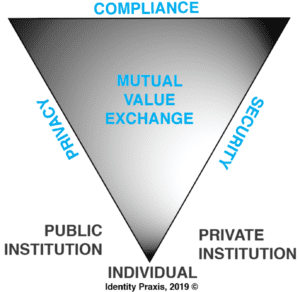Seeing privacy, brand safety and media buying through the personal data value exchange matrix
This article was republished by American Marketer April 16, 2019.
Procter & Gamble Co. chief brand officer Marc Pritchard last week said, “It’s time to create a New Media Supply Chain.”
Speaking April 11 at the ANA Media Conference in Orlando, FL, Mr. Pritchard – representing one of the largest global advertisers in the world – raised a number of reasons why there is a need for a new media supply chain.
According to Mr. Pritchard, today’s media value chain lacks transparency, which leads to:
- Massive media waste
- Outright fraud
- Poor brand safety
- Poor audience satisfaction
I am in violent agreement with him, and agree with his statement, “As the next half of the world’s population gets connected, it’s likely the problems will keep growing.”
We have all experienced media waste. You look at or buy something online and are digitally stalked for months by the same ad across the Internet.
Media waste squanders people’s attention – the most precious resource in the world – and impacts satisfaction, as well as drains brand resources such as time, money and reputation.
On the point of brand safety, who can forget the backlash that YouTube faced in 2018 when beloved household brands such as like Under Armour or the U.K. military discovered their advertising was running alongside extremist content promoting Nazism, conspiracy theories, pedophilia and terrorism?
Brand safety is a big issue that might not be solvable with current systems.
In fact, just last month Google admitted that it might never be able to guarantee with 100 percent brand safety for brands on YouTube.
On the point of fraud, this is a huge issue. EMarketer reports that marketers are losing $6.5 billion ~ $19 billion of their digital ad spent to fraud every year.
In other words, roughly 5 percent to 15 percent of digital ad budgets are funding criminals.
Actions for achieving the New Media Supply Chain
P&G is already well on its way to building its own new media supply chain. The company is “working more closely with media providers, eliminating hidden costs and placing media where it is most effective and efficient.”
Mr. Pritchard reports that the company has trimmed nearly $1 billion in agency fees, decreased media production costs by reducing media wastes by 20 percent, increased media reach by 10 percent, and built out an internal data management platform that houses more than 1 billion consumer IDs worldwide.
Mr. Pritchard claims all this effort has helped P&G get closer to the consumer and is enabling the marketer to be more relevant and effective with its one-to-one marketing.
To scale efforts, however, Mr. Pritchard informs us that P&G does not want to tackle today’s media supply chain problems alone. That is why it is calling for a new media supply chain.
“We are seeking partners who will work with us,” Mr. Pritchard told attendees at the conference last week.
For example, P&G is looking for partners to help the company handle editorial content in a way that is:
- Consistent
- Entertains, informs and engages
- Inclusive
- Standardized
- Promoting freedom of expression
- Creating a balanced and constructive discourse
- Provided by partners that can prove that their content is safe and under their complete control
- Of the highest quality and of the highest integrity
To make his new media supply chain vision a reality Mr. Pritchard provides us with five actions:
- Action 1: Elevate quality, specifically ensuring content quality
- Action 2: Promote civility, notably recognizing that “free speech is a right, but civility is a responsibility.”
- Action 3: Level the playing field, focusing on driving cross-platform media transparency through cross-platform media measurement
- Action 4: Simplify privacy, for the individual, for public and private institutions
- Action 5: Take control, where brands focus on bringing technology and processes in house
New Media Supply Chain coalition and standards
I love the vision and Mr. Pritchard’s five recommended actions to build a new media supply chain.
In regards to Action 4, however, I think we need to think deep and hard on how this is accomplished.
Mr. Pritchard notes that “consumer data is a foundation for how we do business today and a foundation for consumer trust is how we handle privacy.” He points out that handling privacy is a challenge, especially in the United States where there are “27 different laws handling consumer data” and in Europe where GDPR reigns.
Mr. Pritchard said P&G is looking to support an industry-wide privacy standard, one that:
- Commonly applies to all companies, whether a consumer is in California, Florida, Ohio or any other state.
- Explains in consumer-friendly ways how the industry is responsibly handling their data.
- Follows the rules of common sense for consumers, is simple and completely understandable, so each person knows exactly what permission they are granting and what data control they have
To address the challenge around building such a standard, P&G has announced support for the Privacy for America Coalition, an industry effort led by American Association of Advertising Agencies (4A’s), Association of National Advertisers (ANA), Digital Advertising Alliance, Interactive Advertising Bureau (IAB) and Network Advertising Initiative (NAI) to help the United States Congress enact comprehensive federal consumer data privacy and security legislation.
A broader lens: Adding the personal data value exchange matrix lens to the New Media Supply Chain
The new media supply chain recommendations above are solid, but they do not go far enough.
To enable a vibrant industry that generates mutual value exchange amongst individuals, private and public institutions we need to go beyond consumer education and regulation.
Rather, we need to build a deeper understanding of three factors that will enable the industry to build an economy, i.e. the personal information economy, based on mutual value exchange.
In the personal information economy, individuals will play an explicit role in the management and exchange of their personal information, of their privacy, on their terms; and public and private institutions will build new practices around the flows of personal data, around the precepts of privacy.
All parties will take a role in securing personal data. New rules will be set. People will learn to enact their rights, and leading organizations will learn to see compliance not as a legal cost but as a new attribute to raise and differentiate their products and services in the hearts and minds of the people they serve.
Reframing and aligning privacy, compliance

Figure 1: Personal Data Value Exchange Matrix
To understand the personal data value exchange matrix we need to start by understanding its key elements, privacy, security and compliance.
- Privacy: Privacy is the ability for an individual or groups of individuals to determine for themselves when, how, for how long, for what purpose, for what intent, to what extent, and on what terms personal data about them is communicated and exchanged. A new suite of tools and personal information management systems (PIMS) are emerging that will give individuals the ability to wield this control.
- Security: Security is the practice, both process and technical, for safeguarding personal data, ensuring that only approved actors, following the precepts of privacy, have access to individuals personal data.
- Compliance, compliance is the set of rules and enforcements—industry and government codes of conduct, best practices, regulations and repercussions—for keeping personal data private and secure.
It is important to recognize that the approach to developing, and enforcing these rules, and the repercussions if they are not met, varies by region.
In fact, there are three regulatory ideologies at play around the world – what I refer to as the Personal Data Regulation Three Body Problem.
When it comes to the personal data oversight, Europe and other regions focus on the digital sovereignty of the individual. They see the control over personal data as a human right. They take an omnibus approach to regulations, meaning the rules and repercussions apply equally across every player and every sector of the market.
The United States and other regions follow a different approach. They feel those that mine, refine and apply the data own it. They take a sectoral approach where the rules vary by market sector and context.
Finally, other regions such as China take a social engineer approach to personal data, where personal data is collected to help influence social structure and behavior.
For example, last year China announced a social credit [scoring] system, where personal data including behavior are used to give a score to each citizen. The score will influence the jobs a citizen can have, where they can live, and the type of transportation they can take.
When it comes to compliance it is important to recognize that it is not about whether one ideology is better than another. Rather, it is important to understand that they all are in play, at macro and micro levels, and to manage them as a set of “ands” and not a discrete set of “ors.”
For instance, in the United States, all three ideologies are active, as evidenced by the California Privacy Protection Act, the U.S.’ data-driven innovation culture and business models, and the use of data throughout many aspects of its social systems.
TO SUCCEED IN today’s dynamic marketplace, and substantiate a vibrant ecosystem of mutual value exchange, everyone needs to focus on keeping personal data secure, develop and comply with the rules and regulations, and ensure that individuals can maintain their digital sovereignty – their digital self-determination – and their privacy. Doing this will instill trust amongst all market players.
When trust is established, everyone can thrive.
There is so much to be done.
Without a doubt, we need to fix the media value change, but in the process, we can fix it and a lot more by taking a bigger picture and looking at our systems through the lens of the personal data value exchange matrix.
Title Image by Gerd Altmann from Pixabay
Michael Becker is an intentionally recognized identity & personal information management solutions strategic advisor, speaker, entrepreneur, and academic. He advises companies on personal information economy business strategy, product development, business development, and sales & marketing strategies. He also represents them at leading trade groups, including the Mobile Ecosystem Forum. Michael is an advisor to Assurant, Predii, Privowny, and Phoji. He is the co-author of Mobile Marketing for Dummies and a number of other books and articles related to mobile marketing, identity, and personal information management. He is on the faculty of marketing of the Association of National Advertisers and National University. A serial entrepreneur, Michael founded Identity Praxis, co-founded mCordis and The Connected Marketer Institute, was a founding member of the Mobile Marketing Association (MMA), and was on the MMA board of directors for ten years and was MMA’s North American Managing Director for three years. In 2004, Michael co-founded iLoop Mobile, a leading messaging solutions provider. In 2014, Michael was awarded the 2014 Marketing EDGE Edward Mayer Education Leadership Award for his commitment to marketing education.

